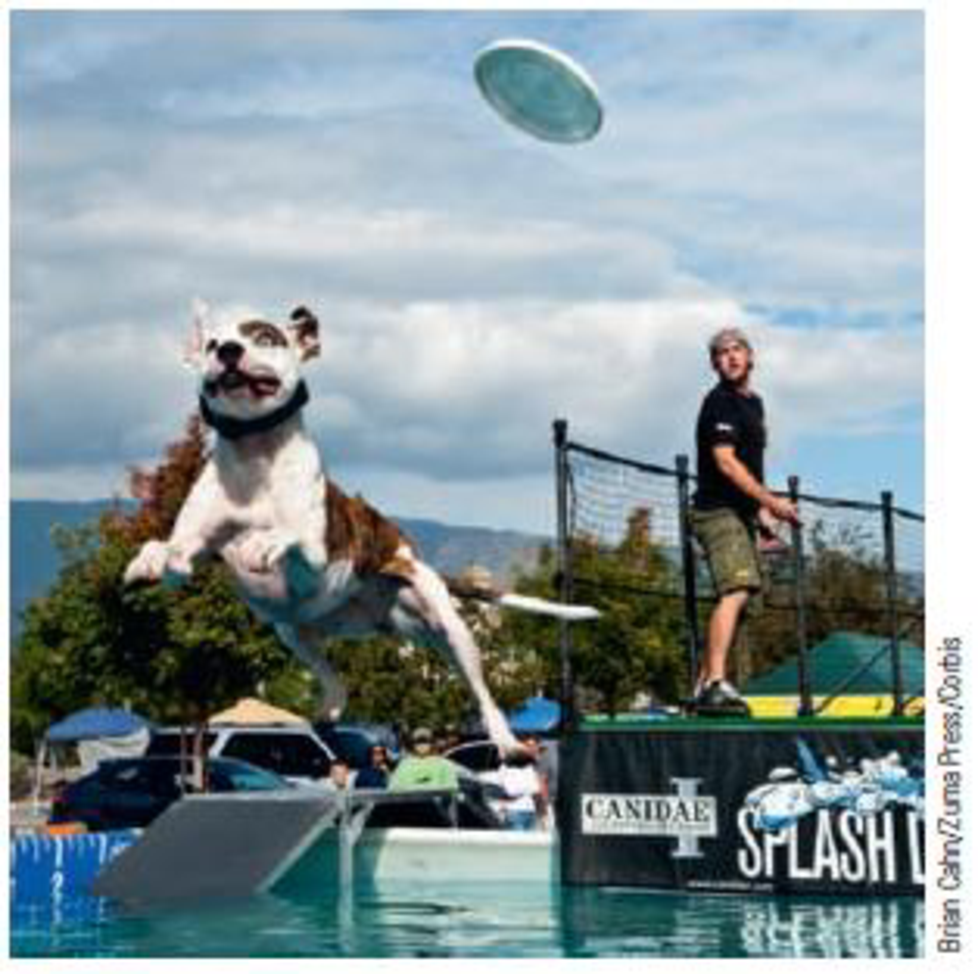
Concept explainers
Dock diving is a great form of athletic competition for dogs of all shapes and sizes (Fig. P4.33). Sheba, the American Pit Bull Terrier, runs and jumps off the dock with an initial speed of 9.02 m/s at an angle of 25° with respect to the surface of the water. a. If Sheba begins at a height of 0.84 m above the surface of the water, through what horizontal distance does she travel before hitting the surface of the water? b. Write an expression for the velocity of Sheba, in component form, the instant before she hits the water. c. Determine the peak height above the water reached by Sheba during her jump.

FIGURE P4.33
(a)
The horizontal distance travelled by Sheba before hitting the surface of the water.
Answer to Problem 33PQ
The horizontal distance travelled by Sheba before hitting the surface of the water is
Explanation of Solution
Sheba, the dog, is dock diving in an athletic competition for dogs and jumps off the dock with an initial speed of
Write the formula for the vertical position
Here,
Write the formula for the horizontal position
Here,
Sheba jumped from initial position
The vertical acceleration is due to gravity pulling the Sheba in direction downward,
Substituting
Solving the quadratic equation, the valuable root is
The time taken for Sheba to reach the water surface is
Substitute
Thus, the horizontal distance travelled by Sheba before hitting the surface of the water is
(b)
Write the velocity of Sheba at the instant before she hits the water in component form.
Answer to Problem 33PQ
The velocity of Sheba at the instant before she hits the water in component form is
Explanation of Solution
Write the formula for the velocity vector equation for the projectile motion
Here,
The horizontal velocity component is
The vertical velocity component is
Substituting in equation (III) to find the value of
Thus, the velocity of Sheba at the instant before she hits the water in component form is
(c)
The peak height above the water surface reached by Sheba during her jump.
Answer to Problem 33PQ
The peak height above the water surface reached by Sheba during her jump is
Explanation of Solution
Write the formula for the vertical velocity component for the projectile motion
The initial vertical velocity of Sheba is
Substituting
The time taken for Sheba to reach the peak height is
Substituting
Thus, the peak height above the water surface reached by Sheba during her jump is
Want to see more full solutions like this?
Chapter 4 Solutions
Physics For Scientists And Engineers: Foundations And Connections, Extended Version With Modern Physics
- 1. What is the spring constant of a spring that starts 10.0 cm long and extends to 11.4 cm with a 300 g mass hanging from it?arrow_forwardplease help me solve all parts of this question from physics. thanks so much in advance! :)))arrow_forwardA fluid with density 263 kg/m3 flows through a pipe of varying diameter and height. At location 1 the flow speed is 13.5 m/s and the diameter of the pipe is 7.4 cm down to location 2 the pipe diameter is 16.9 cm. Location 1 is 6.3 meters higher than location 2. What is the difference in pressure P2 - P1? Using units in Pascals and use g = 9.81 m/s2.arrow_forward
- The kitchen had a temperature 46 degrees Fahrenheit and was converted it to Kelvin. What is the correct number for this temperature (46 F) on the Kelvin scale?arrow_forwardWater is traveling at a speed of 0.65 m/s through a pipe with a cross-section radius of 0.23 meters. The water enters a section of pipe that has a smaller radius, only 0.11 meters. What is the speed of the water traveling in this narrower section of pipe?arrow_forwardA particular water pipe has a radius of 0.28 meters. If the pipe is completely filled with water, moving with average velocity 0.45 m/s, what is the flow rate of water through the pipe with units of cubic meters of water per second?arrow_forward
- Water is flowing through a horizontal pipe with two segments. In one segment, the water flows at a speed v1 = 4.52 m/s. In the second segment the speed of the water is v2 = 2.38 m/s. Based on Bernoulli's Principle, what is the difference in pressure (P2 - P1) between the two segments? Assume that the density of the water is 997 kg/m3 and give your answer as the number of Pascals (i.e. N/m2).arrow_forwardWater from the faucet is supplied to the hose at a rate of 0.00057 m3/s. At what speed (number of meters per second) does the water exit the nozzle if the cross sectional area of the narrow nozzle is 2.1 x 10-6 m2?arrow_forwardJason Fruits/Indiana University Research Communications Silver/ silver oxide Zinc zinc/oxidearrow_forward
- Car P moves to the west with constant speed v0 along a straight road. Car Q starts from rest at instant 1, and moves to the west with increasing speed. At instant 5, car Q has speed w0 relative to the road (w0 < v0). Instants 1-5 are separated by equal time intervals. At instant 3, cars P and Q are adjacent to one another (i.e., they have the same position). In the reference frame o f the road, at instant 3 i s the speed o f car Q greater than, less than, or equal to the speed of car P? Explain.arrow_forwardCar P moves to the west with constant speed v0 along a straight road. Car Q starts from rest at instant 1, and moves to the west with increasing speed. At instant 5, car Q has speed w0 relative to the road (w0 < v0). Instants 1-5 are separated by equal time intervals.arrow_forwardCar P moves to the west with constant speed v0 along a straight road. Car Q starts from rest at instant 1, and moves to the west with increasing speed. At instant 5, car Q has speed w0 relative to the road (w0 < v0). Instants 1-5 are separated by equal time intervals. Sketch and label a vector diagram illustrating the Galilean transformation of velocities that relates velocity of car P relative to the road, velocity of car Q relative to road, and velocity of car Q relative to car P at instant 3. In the frame of car P, at instant 3 is car Q moving to the west, moving to the east, or at rest? Explain.arrow_forward
 Principles of Physics: A Calculus-Based TextPhysicsISBN:9781133104261Author:Raymond A. Serway, John W. JewettPublisher:Cengage Learning
Principles of Physics: A Calculus-Based TextPhysicsISBN:9781133104261Author:Raymond A. Serway, John W. JewettPublisher:Cengage Learning Physics for Scientists and Engineers: Foundations...PhysicsISBN:9781133939146Author:Katz, Debora M.Publisher:Cengage Learning
Physics for Scientists and Engineers: Foundations...PhysicsISBN:9781133939146Author:Katz, Debora M.Publisher:Cengage Learning Physics for Scientists and Engineers with Modern ...PhysicsISBN:9781337553292Author:Raymond A. Serway, John W. JewettPublisher:Cengage Learning
Physics for Scientists and Engineers with Modern ...PhysicsISBN:9781337553292Author:Raymond A. Serway, John W. JewettPublisher:Cengage Learning Glencoe Physics: Principles and Problems, Student...PhysicsISBN:9780078807213Author:Paul W. ZitzewitzPublisher:Glencoe/McGraw-Hill
Glencoe Physics: Principles and Problems, Student...PhysicsISBN:9780078807213Author:Paul W. ZitzewitzPublisher:Glencoe/McGraw-Hill Physics for Scientists and Engineers, Technology ...PhysicsISBN:9781305116399Author:Raymond A. Serway, John W. JewettPublisher:Cengage Learning
Physics for Scientists and Engineers, Technology ...PhysicsISBN:9781305116399Author:Raymond A. Serway, John W. JewettPublisher:Cengage Learning Physics for Scientists and EngineersPhysicsISBN:9781337553278Author:Raymond A. Serway, John W. JewettPublisher:Cengage Learning
Physics for Scientists and EngineersPhysicsISBN:9781337553278Author:Raymond A. Serway, John W. JewettPublisher:Cengage Learning





